#arctium minus
Explore tagged Tumblr posts
Text
Last of the summer wine: autumn wildlife
#alomena prasina#Arctium minus#autumn wildlife#Caddisfly#Cirsium eriophorum#Common green shieldbug#German wasp#Helina evecta#Helina impuncta#Lesser burdock#Muscidae#Red admiral#Vanessa atalanta#Vespula germanica#Wasps#woolly thistle
0 notes
Text
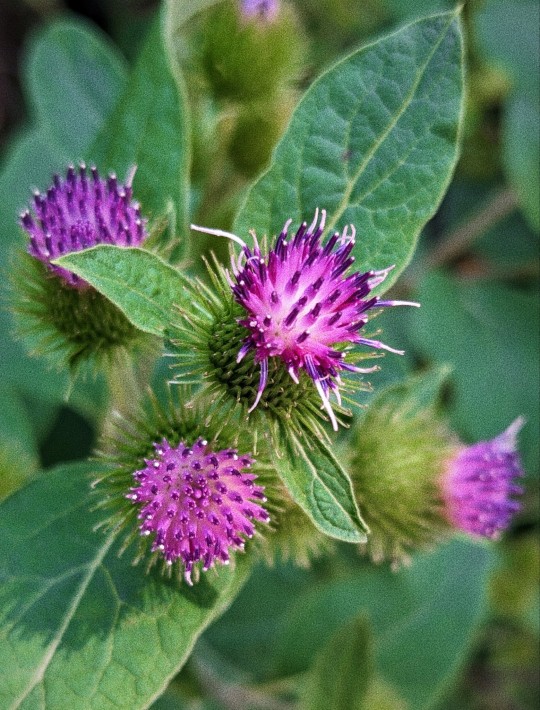
#burdock#wild edibles#close up#forageables#summer time#ontario#flora#thistley#thistle#arctium minus#button bur#cuckoo button#asteraceae#walking around
0 notes
Text
List of Herbs & Uses ( + Other tools)
DO NOT USE THIS AS FACT. THIS IS FOR FAKE CATS. DO NOT USE THIS IN REAL LIFE. I AM SERIOUS.
CW; FOR MENTION OF SPIDERS, LEECHES, FLEAS AND WOUNDS
Psss shoutout to @bonefall ‘s herb guide. Helped me a lot + inaturalist thing. Really helped
Alder (Alnus glutinosa) Bark - Chewed to ease toothaches. Found along rivers, can also grow in swampy areas.
Burdock (Arctium minus) Root - The root is dug up, the soil is washed off, and then it is chewed into a pulp. Soothes and heals rat bites especially if they are infected. Can be used for other wounds, more commonly bite wounds. Helps to prevent infections or fight off infections. Prefers moist soil and full sun. Will tolerate most soils. Very dangerous to dig up, only trained Healers can do this.
Catmint (Nepeta x faassenii) - Used as a treatment for Greencough. It can also improve relaxation, which may reduce anxiety, restlessness, and nervousness. Found in Twolegs gardens. Thrives in areas with dry soil and is very tolerant of dryer conditions.
Chamomile (Matricaria chamomilla) - Used as a anticonvulsant herb for cats with epilepsy. MUST BE STEEPED IN WATER. The herb also has a side effect of drowsiness. IN LARGE DOSES IT CAN BE TOXIC! This is why it’s steeped in water. Grows basically anywhere but prefers sunny areas with free draining soil.
Chervil (Chaerophyllum temulum) - Chewed to extract the juice of the leaves for infected wounds or the root for bellyaches. Grows best in a cool, partly shaded spot.
Chew sticks - A small twig from a young willow or Silver Birth tree. First chew the end off. Once that is finished they ‘brush’ their teeth with the bristles, shifting it in their paws to cover the whole mouth.
Cobweb - A cobweb is fluffy and messy. They are made by a cobweb spider and it is used to stop or slow bleeding.
Comfrey ( Symphytum officinale ) - Roots are chewed into a poultice and leaves are chewed into a pulp. Can help for broken bones, soothes wounds, burns and wrenched claws. Can be used to help with itching or for inflammation on stiff or wrenched joints. Also eases stiffness on wrenched shoulders when lined in a nest. IF USED TOO MUCH IT CAN BE TOXIC!!! Found in damp, grassy places.
Fennel (Foeniculum vulgare) - ...Just check this post out. TLDR; it has way too many uses. It grows in most but grows best in sunny sites with free draining soil. It does not like too much shade, and will struggle if the soil is prone to becoming waterlogged.
Feverfew (Tanacetum parthenium) - When eaten it reduces body temperature for cats with fever or chills. Helps with headaches. It also reduces all inflammation and swelling. Grows anywhere sunny, not too picky about soil types.
Flea Bath - ...Self explanatory
Herb Robert (Geranium robertianum) - When eaten it can help with grief. Grows anywhere sunny, not too picky about soil types. Can flourish in part shade.
Honey - Used for bacterial infection, especially eye bacterial infection.
Horehound (Lycopus europaeus) - Given to trans cats as a hormone suppressants. If they suddenly stop or overdose it can cause thyroid enlargement. Horehound can also be used to treat anxiety, heart palpitations, stopping bleeding, and respiratory illness. Grows best in full sun and sandy well-drained soil.
Leech (Hirudo medicinalis) - Used for joint pain.
Mint (Genus Mentha) - Used to cover a cat on a funeral if the body is particularly bad. Very toxic, don't use often.
Mullein (Verbascum thapsus) - Mainly used to treat Yellowcough. TOXIC IN LARGE DOSES. Found in well-lit, disturbed soils.
Salt - Insect repellant!
Scots Pine (Pinus sylvestris) Pollen - Added to water and food to increase testosterone.
Splint - A strip of rigid material used for supporting and immobilizing a broken bone when it has been set.
Poppy seeds (Papaver somniferum) - Can help a cat sleep, soothe shock or distress, or ease pain. Not recommended for nursing queens. Flourishes in dry, warm climates.
Rosemary (Salvia rosmarinus) - Used as a hormone suppressant for cats going to female to male. Also used as a antifungal and used when cooking. It grows best in a sunny, sheltered spot, in well-drained soil.
Stinging Nettle (Urtica dioca) + Root - First must be processed first. Used to treat burns and inflammation. The root can be taken by a transmasc warrior.
Valerian (Valeriana officinalis) - It is used to aid in anxiety and stress. Makes a cat more active. Used as a anticonvulsant herb. Side effect is it causes cats to perk up. Can be found anywhere with good drainage but it prefers sandy loam.
Web - A web is flat and neat. They are made by most spiders and it is used to stop or slow bleeding.
Yarrow (Achillea millefolium) - When eaten it can induce vomiting. If more than a small amount is eaten it can cause death. Thrives best in sunny areas but will tolerate some shade. Doesn't tolerate constantly wet soil and prefers well-drained soil. Thrives in hot and dry conditions.
(READ BELOW FOR NOTES)
Notes
Lots of herbs are now gone
Almost all mint is toxic to cats btw
Sorry marigold lovers, but it doesn't grow naturally in the general area I'm basing this off of.
...Most of the herbs don't grow naturally in this general area.
Mostly in towns
Probably going to do a territory thing of Thunder Guild where I list plants, prey and stuff like that
I got rid of most herbs because they A; don't grow here or B; too toxic for kitties
Btw if you want to either dock species (curly dock or board leaved dock) could work but only in small doses
#Warriors#Warrior Cats#erin hunter warriors#wc#wcantinomy#herb guide#medicine guide#warriors herb guide#warriors medicine guide#cw; spiders#cw; leeches#cw; fleas#only mentions though#this took too long#warriors rewrite#warrior cats rewrite#wc rewrite
24 notes
·
View notes
Text


Arctium minus, EN: Lesser burdock, NL: Gewone klit
So excited with my unadvertised plant identifier app that I immediately used it on this cutie that is in an incredibly inconvenient spot in the garden but I won't let J remove it as there are many butterflies around it. Turns out this was the plant that inspired velcro! It's a two-year plant, in it's first year it's roots can be eaten much like parsnip/salsify! In it's second year it develops the flowers and the root becomes too wood-like to eat. So I guess I'm collecting seeds this fall and try the root next year!!
2 notes
·
View notes
Text
Arctium Minus
In the tapestry of garden delights, Lesser Burdock unfolds as a herbal gem, weaving its intricate leaves and charming burr-like flowers into the story of your green haven. Let's embark on a journey to explore the wonders and potential benefits of this resilient and captivating plant. 🪴🌸
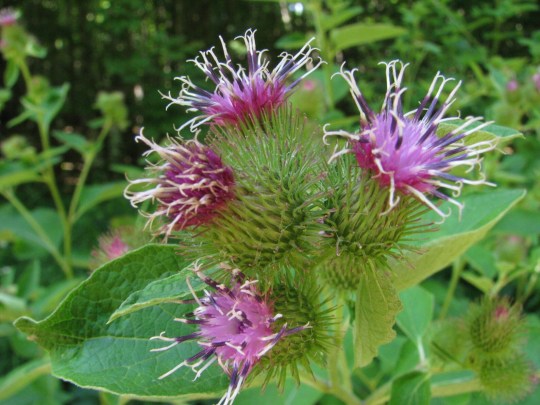
But why should you consider growing Lesser Burdock in your garden? Here are a few compelling reasons:
Herbal Heritage: Lesser Burdock has a rich herbal legacy, historically used for its potential medicinal properties, including promoting skin health and overall well-being.
Wildlife Haven: The distinctive flowers of Lesser Burdock attract pollinators, adding a lively touch to your garden and supporting local biodiversity.
Culinary Potential: The young leaves of Lesser Burdock are edible and can be used in salads or cooked dishes, offering a unique addition to your culinary adventures.
Resilient Beauty: Lesser Burdock's hardy nature makes it an easy-to-care-for plant, thriving in a variety of conditions and adding a touch of resilience to your garden.
Embrace the herbal wonders of Lesser Burdock and let its unique features and potential benefits enrich your garden and well-being. Join us in savoring the delights of this captivating herbal gem! 🪴🌎
Visit our Etsy shop to bring the beauty and potential benefits of Lesser Burdock to your garden. Each seed is an invitation to cultivate a herbal treasure that adds character and resilience to your green space. 🌿🌸
#ArctiumMinus#LesserBurdock#HerbalGarden#MedicinalHerbs#CulinaryAdventures#Biodiversity#GardenResilience#HerbalWisdom
0 notes
Text
Burdock #plant
Arctium minus. Picture taken September 2. #plants #nature #naturephotography #woods #burdock

View On WordPress
0 notes
Text

Lesser burdock (Arctium minus). Also known as little burdock, louse-bur, common burdock, button-bur, cuckoo-button or wild rhubarb.
1 note
·
View note
Text
Burdocks: Exploring the Medicinal and Culinary Wonders of Arctium
Burdocks, scientifically known as Arctium lappa, are a group of perennial plants belonging to the Asteraceae family. These plants are known for their unique characteristics and various uses. The burdock plant typically grows up to three meters tall, featuring large, heart-shaped leaves and purple flowers that bloom in clusters. It is widely distributed across Europe, Asia, and North America, thriving in temperate climates.
One notable application of burdock is the production of burdock tea. The roots of the Arctium plant are harvested and dried to create this herbal beverage. Burdock tea is known for its distinct earthy flavor and numerous health benefits. It is rich in antioxidants, vitamins, and minerals, making it a popular choice among herbal tea enthusiasts. Regular consumption of burdock tea is believed to support digestion, promote detoxification, and boost the immune system.
Arctium, the genus to which burdock belongs, comprises several species. One of the most common species is Arctium minus, commonly known as common burdock. This species is characterized by its long-stemmed leaves and burrs that cling to clothing or animal fur, facilitating seed dispersal. Common burdock has been used in traditional medicine for centuries due to its diuretic, anti-inflammatory, and antibacterial properties. It has been employed to treat various ailments, including skin conditions, arthritis, and urinary tract infections.
Burdock seeds are another valuable component of this plant. These seeds are enclosed within the burrs, which are well-known for their ability to stick to surfaces. This mechanism allows for efficient seed dispersal, as the burrs easily latch onto passing animals or human clothing. This characteristic has earned burdock the reputation of being a "hitchhiker" plant. Moreover, the seeds contain essential fatty acids and plant sterols, making them a nutritious food source.
Among the different species of burdock, the greater burdock (Arctium lappa) stands out. This particular species is known for its larger leaves, sturdy stem, and greater medicinal potential. The roots of greater burdock have been used in traditional Chinese medicine as a remedy for various ailments. They are believed to have anti-inflammatory, antimicrobial, and hepatoprotective properties. In addition to its medicinal value, greater burdock has also found culinary uses, particularly in Asian cuisine. The young stems and leaves are often consumed as vegetables, while the roots are used in soups, stews, and stir-fries.
In conclusion, burdocks, specifically the Arctium genus, are a diverse group of plants with significant medicinal and culinary importance. The production of burdock tea from the roots provides a healthy beverage option, while the various species of burdock offer different medicinal properties. Common burdock is renowned for its traditional uses, while the greater burdock showcases enhanced therapeutic potential. With its unique characteristics, burdock continues to captivate both herbal enthusiasts and those interested in exploring its wide range of applications.

0 notes
Text

The Burdock Fairy (Cicely Mary Barker)
Wee little hooks on each brown little bur,
(Mind where you’re going, O Madam and Sir!)
How they will cling to your skirt-hem and stocking!
Hear how the Burdock is laughing and mocking:
Try to get rid of me, try as you will
Shake me and scold me, I’ll stick to you still,
I’ll stick to you still!
#p#art#cicely mary barker#fairies#burdock#flower fairies#imaginal realms#herbarium#Arctium lappa#Arctium minus#plants#nature#herbs#storybook illustration#fairycore#naturecore#poetry#whimsical
31 notes
·
View notes
Text
#summer#butterflies#butterfly#bugs#bug#insect#insects#flowers#birds#sunshine#sun#commonburdock#burdock#plant#plants#botany#arctium minus
2 notes
·
View notes
Photo


Common Burdock Arctium minus Asteraceae (Aster) Family
Photographs taken on January 19, 2019, along the Etobicoke Creek Trail, Mississauga, Canada.
#wildflowers of southern ontario#wildflowers#flowers#nature#winter#Common Burdock#burdock#Arctium minus#Asteraceae#Etobicoke Creek Trail#trail#snow#ontario#canada
5 notes
·
View notes
Text

7/31/21
0 notes
Text
Burdock
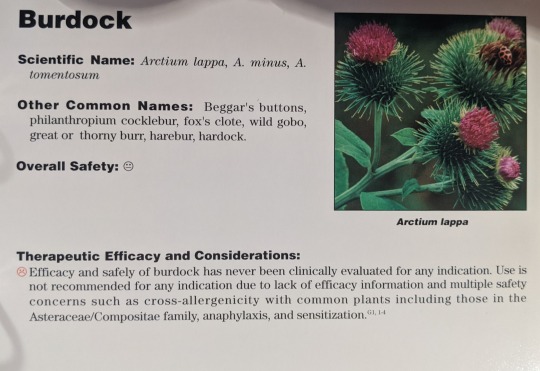

Scientific Names: Arctium lappa, A. minus, A. tomentosum Other Common Names: Beggar’s buttons, philanthropium cocklebur, fox’s clote, wild gobo, great or thorny burr, harebur, hardock Overall Safety: 😐
Therapeutic Efficacy and Considerations:
🙁 Efficacy and safety of burdock has never been clinically evaluated for any indication. Use is not recommended for any indication due to lack of efficacy information and multiple safety concerns such as cross-allergenicity with common plants including those in the Asteraceae/Compositae family, anaphylaxis, and sensitization.
Chemistry/Pharmacology: Burdock root contains up to 50% inulin, multiple non-hydroxy acids (e.g., stearic, lauric, palmitic) and polyacetylenes which are believed responsible for Gram-negative antimicrobial activity. In vitro studies have shown Gram-negative and Gram-positive activity. Animal studies have demonstrated hypoglycemic and uterine antimutagenic and antitumor activities. Burdock may also hepatoprotective effects against ethanol, acetaminophen, and carbon tetrachloride.
Drug Interactions: Theoretically, use with oral hypoglycemics and insulin may increase hypoglycemic effects, and use with anticoagulant or antiplatelet drugs might increase the risk of bleeding due to decreased platelet aggregation.
Contraindications/Precautions: Contraindicated in pregnancy due to uterine stimulant activity; lactation due to unknown effects; allergy to ragweed, chrysanthemums, marigolds, or daisies; and in diabetes. Note: Due to similar appearances, burdock can be adulterated with belladonna or deadly nightshade, causing atropine poisoning. This has occurred with commercial burdock preparations.
Adverse Effects: Anaphylaxis or other allergic reactions. Sensitization may occur with topical use.
#sigler dietary supplement drug cards#2nd edition#burdock#arctium lappa#arctium minus#arctium tomentosum#beggar's buttons#philanthropium cocklebur#fox's clote#wild gobo#grear burr#thorny burr#harebur#hardock#drug facts
0 notes
Text

A - Arctium minus (Hill) Bernh. - Bardana minore (Asteraceae)
16 notes
·
View notes
Text
The Quest For Truth: Wildflower ID Part 1
The Quest For Truth: Wildflower ID Part 1


Convolvulus arvensis (Field Bindweed) on 6-24-19.
Hello everyone! I hope this post finds you all well. I guess the title of this post could get some attention for many reasons. Many of us are on a quest for the truth about something because, after all, the truth will set you free. We wonder about the truth of who we are when traditional religious teaching leaves us asking questions we are told…
View On WordPress
#Arctium minus (Burdock)#Asclepias sp.#Asclepias sullivantii (Prarie Milkweed)#Convolvulus arvensis (Field Bindweed)#Ruellia humilis (Wild Petunia)#Vernonia sp. (Ironweed)
0 notes
Text
Safe Aviary Plants and Toxic Plants for Birds@|what plants can i put in an outdoor aviary@|@|24

Plants not only add aesthetic value to an otherwise sterile-looking enclosure, but they also provide a more natural, engaging, and secure environment for the inhabitants to enjoy. Using plants to create visual barriers within the flight may help reduce aggression among cagemates by providing objects for the birds to hide behind.5 This in turn helps to make the birds feel more secure, and may therefore result in reduced stress levels. Foliage in the cage gives the birds something to occupy themselves with–birds often chew on, play within, and even build nests out of plants placed in their living space.
For this reason, care must be taken when selecting plants to decorate a flight. Both live and fake plants may be used, but all parts of the plant must be safe and nontoxic. The best fake plants to use are constructed of untreated silk and plastic. Make sure the silk plants do not have any components that may be easy for a bird to consume, tangle itself in, get caught on, or stuck by. Treated wood baskets and paper plants may be hazardous choices and are not recommended for decorating flights. Two benefits of using silk plants are: 1) they are not as easily destroyed by the birds, and 2) they can be scrubbed clean and disinfected as needed.
[external_link_head]
Live plants tend to demand more upkeep and may need to be replaced more frequently, as finches often love to pick them apart. Try to obtain plants that have not been sprayed with any pesticides or chemicals, and be sure to rinse the plants off before placing them in and around the flight. Do not add any fertilizers to the soil (they are toxic);6 if fertilizers are already present in the soil, repot the plant with uncontaminated soil. Leaving each plant in its pot is suggested, in case a plant dies and needs to be removed.
Helpful Hints41
Placement Plantings should be spaced appropriately to allow room for flight paths and to permit the birds to access to the floor of the enclosure. Walk-in enclosures should also have planned pathways for birdkeeper access. Be careful to provide climbing vines with trellis to support the weight of their growth; otherwise they could break the aviary mesh and allow escape of the birds.
Selection Aside from ensuring that the plant(s) you have selected are non-toxic, try to avoid purchasing plants which are tall and rapidly-growing as these will require constant pruning. In addition to considering what plants are best suited for your area, don’t forget to also consider the needs of the birds. Avadavats and Munias enjoy climbing small bamboos and grasses, for example, Munias and Mannikins prefer to weave their nests into grass clumps, and Weavers need palm leaves and broad-leafed grasses for nesting material.
Timing of Live Plantings Plants should be added to the enclosure as it is being completed. The plants should be allowed to grow sufficiently before adding the birds; this way, the plants will be better able to withstand being nibbled on. Ideally plants should produce their densest foliage while the birds are nesting.
Safe Aviary Plants25,17
When choosing plants for your aviary, consult a botanist or experienced gardener who can help you select plants which are suitable for planting in your locale (considering your hardiness zone, soil type, sun exposure, etc.). Below are some options which have been listed as safe for birds.
Note: Please be aware that roses and bougainvillea have thorns.
Outdoor Plants
Trees & Shrubs Acacia Almond Arbutus Ash
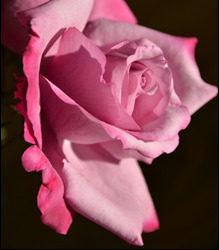
Aspen Autumn olive Bayberry Birch Bladdernut Blueberry Camellia Cottonwood Dogwood Elm Fir (balsam, douglas, subalpine, white) Forsythia Fuchsia Guava Hawthorn Larch Madrona Magnolia Mango (zone 9+) Manzanita Mountain ash Nectarine Papaya (zone 10+) Pear (as long as the seeds aren’t eaten) Pine (ponderosa, spruce, Virginia, white) Pittosporum (zone 9+) Poplar Pyracantha Raspberry Rose Rubus odoratus Spruce (black, Norway, red, white) Viburnum White poplar
Vines Bougainvillea (can also be grown as shrub or small tree) Grape vine Russian Vine (Polygonum baldschuanicum)
[external_link offset=1]
Grasses & Herbs Bamboo Oregano Rosemary Thyme
Ground Cover and Short Plants Baby’s tears aka Polka Dot Plant (Helxine soleirolii) Chickweed Creeping jenny (Lysimachia)
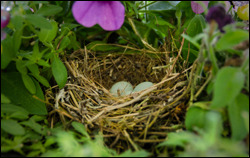
Wild passerines built a nest in a hanging petunia.
Dandelion Marigold Mother of pearl Nasturtium (zone 9+) Petunia Piggyback begonia (Begonia hispida variant Cucullifera) Piggyback plant Plectranthus (zone 9+) Sedum Thistle White clover
Indoor Plants (Safe Houseplants) and Tropical Plants
African violet (Saintpaulia spp., Episcia reptans) Aluminum plant (Pilea cadierei)
Bird’s Nest Fern (Asplenium nidus) Boston Fern (Nephrolepis exaltata) Bloodleaf Bromeliads Burro’s tail Cactus (except pencil, peyote, mescaline, candelabra) Christmas cactus (Schlumbergera bridgesii) Cissus: Danish ivy aka Grape Ivy (Cissus rhombifolia), Kangaroo vine (Cissus antarctica)
Emerald ripple peperomia
Flame nettle (Coleus sp.) Gold-fish plant Hens & chickens
Lipstick plant
Madagascar jasmine Monkey plant Nerve plant Palms:
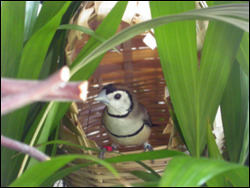
Potted palms provide privacy around the nest.
Areca (Chrysalidocarpus lutescens)
Bamboo (Chamaedorea erumpens)
Butterfly Cane
Canary Island (Phoenix canariensis)
Date
European Fan (Chamaerops humilis)
Fishtail
Golden Feather
Paradise/Kentia (Howea foresterana)
Parlor (Chamaedorea elegans)
Lady (Raphis excelsa)
Madagascar
Miniature Fan
Phoenix
Pygmy Date
Robelein Lady
Sentry
Wine
Peacock plant (Calathea) Pepperomia (Pepperomia sp.) Prayer plant (Maranta leuconeura) Purple Passion aka Velvet Plant (Gynura aurantiaca) Spider plant (Chlorophytum comosum) Swedish ivy (Plectranthus verticillatus)
Wandering jew (Tradescantia sp.) including Giant white inch plant Wax plant (Hoya carnosa) Zebra plant (Aphelandra squarrosa)
Plants which Allow for Perching Dwarf or Hawaiian Schefflera (Schefflera arboricola) Umbrella tree/Schefflera (Brassaia actinophylla) False aralia
Toxic Plants
Plant toxicosis in birds occurs if they chew on or ingest toxic plants. The toxic reaction can be due to pesticide residues on the plants, or to toxins within the plants themselves. Birds which chew on toxic plants may develop oral irritation; if they ingest enough, systemic clinical signs can occur such as vomiting or diarrhea. There is likely significant species differences in sensitivity,16 and studies are lacking. However, plants which have been reported as toxic in some birds, or which are considered to be potentially toxic include:6,25,52,29,56,16,17,28
Common Name Scientific Name Poisonous Part Symptoms Aconite Aconitum sp. all parts Agapanthus Agapanthus sp. sap Amaryllis Amaryllidaceae bulbs American yew Taxus canadensis needles, seeds Apple seeds Apricot pits Arrowhead vine Syngonium podophyllum leaves Arum Lily Arum sp. all parts Autumn crocus Colchicum autumnale all parts Avocado Persea americana pits, skin, flesh Reduced activity, inability to perch, fluffing feathers, labored breathing, rapid death, generalized tissue congestion. Azalea Rhododendron occidentale leaves Balsam pear Memordica charantia seeds, fruit rind Baneberry Actaia sp. berries, roots Bay tree Laurus nobilis Beans all types if uncooked Belladonna Atropa belladonna all parts Bird of paradise Caesalpina gilliesii seeds Bishop’s weed Ammi majus Bittersweet nightshade Solanum dulcamara immature fruit Black locust Robina pseudoacacia bark, sprouts, foliage Blue-green algae Schizophycaea sp. some forms toxic Hepatotoxic, lethal respiratory arrest. Boxwood Buxus sempervirens leaves, stems Buckthorn Rhamnus sp. fruit, bark Burdock Arctium minus Buttercup Ranunculus sp. sap, bulbs Caladium Caladium sp. leaves Calla lily Zantedeschia aethiopica leaves Severe irritation of mucous membranes, edema & irritation may take weeks to subside; severe dyspnea; severe keratoconjunctivitis if plant juices contact eyes. Vomiting, diarrhea. Camel bush Trichodesma incanum Candelabra cactus Euphorbia lactea sap Castor bean or Castor oil plant Ricinus communis beans, leaves Vomiting, diarrhea (possibly bloody), necrosis of organs (liver, spleen, lymph nodes, stomach, intestine) in mammals. Chalice vine Solandra sp. all parts Cherry bark, twigs, leaves, pits Cherry laurel Prunus laurocerasus clippings release cyanide fumes Chinese evergreen Aglaonema modestum all parts Christmas candle Pedilanthus tithymaloides sap Chrysanthemum Chrysanthemum sp. leaves, stems, flowers Clematis Clematis sp. all parts Coffee bean Sesbania sp seeds Gastroenteritis, can be fatal. Hyperthermia, hypertension, hyperactivity, seizures, tachycardia. Coral plant Jatropha multifida seeds Cowslip Caltha polustris all parts Croton Codiaeum sp. sap Crown of thorns Euphorbia milii sap Daffodil Narcissus sp. bulbs Daphne Daphne sp. berries Datura Datura sp. berries Deadly amanita Amanita muscaria all parts Death camas Zygadenis elegans all parts Delphinium Delphinium sp. all parts Diffenbachia or Dumb cane Dieffenbachia picta, sp. leaves Severe irritation of mucous membranes, edema & irritation may take weeks to subside; severe dyspnea; severe keratoconjunctivitis if plant juices contact eyes. Vomiting, diarrhea. Eggplant Solanaceae sp. all parts except fruit Elephant’s ear Colocasis sp. or Alocasia sp. leaves, stems Severe irritation of mucous membranes, edema & irritation may take weeks to subside; severe dyspnea; severe keratoconjunctivitis if plant juices contact eyes. Vomiting, diarrhea. English ivy Ilex aquafolium berries, leaves English yew Taxus baccata needles, seeds Ergot Claviceps purpurea present in poorly stored seed, silage, dog food Gangrene, hyperexcitability, seizures. Euonymus Euonymus sp. all parts False henbane Veratrum woodii all parts Flamingo flower Anthurium sp. leaves, stems Foxglove Digitalis purpurea leaves, seeds Digitalis glycoside – vomiting, bradycardia, arrhythmias, heart block Golden chain Laburnum anagyroides all parts Hemlock (poisoin and water) Conium sp. all parts Henbane Hyocyanamus niger seeds Holly Ilex sp. berries Horse chestnut Aesculus sp. nuts, twigs House plant ferns Pteris sp. Hyacinth Hyancinthinus orientalis bulbs Hydrangea Hydrangea sp. flower bud Iris Iris sp. bulbs Ivy Hedera sp. leaves, berries Jack-in-the-pulpit Arisaema triphyllum all parts Japanese yew Taxus cuspidata needles, seeds Java bean (lima bean) Phaseolus lunatus uncooked beans Jerusalem cherry Solanum pseudocapsicum berries Arrhythmias, bradycardia, heart block, severe gastroenteritis, calcification of vascular system, lungs, kidneys. May be teratogenic. Jimsonweed Datura sp. leaves, seeds Tachycardia, convulsions, death. Juniper Juniperus virginiana needles, stems, berries Lantana Lantana sp. immature berries Larkspur Delphinium sp. all parts Laurel Kalmia, Ledum, Rhodendron sp. all parts Lily Lilium sp. bulbs Lily of the valley Convallaria majalis all parts, including water housing the plant Vomiting, diarrhea, cardiac arrhythmias, bradycardia, heart block. Lobelia Lobelia sp. all parts Locoweed Astragalus mollissimus or Astragalus emoryanus all parts Hyperexcitability and locomotor difficulty. Lords and ladies Arum sp. all parts Lupin Lupinus sp. Marijuana Cannabis sativa leaves Maternity plant Klanchoe sp. Mayapple Podophyllum sp. all parts except fruit Mescal bean Sophora sp. seeds Milkweed Asclepias sp. Weakness, ataxia, seizures, cardiovascular signs. Mistletoe Santalales sp. berries Mock orange Poncirus sp. fruit Monkshood Aconitum sp. all parts Morning glory Ipomoea sp. all parts Narcissus Narcissus sp. bulbs Nightshades Solanum sp. berries, leaves Arrhythmias, bradycardia, heart block, severe gastroenteritis, calcification of vascular system, lungs, kidneys. May be teratogenic. Oak Quercus sp. Anorexia, diarrhea, small intestinal ulceration and hemorrhage, renal failure & polydypsia, hepatotoxic, can be fatal. Oleander, bay laurel Nerium oleander all parts Digitalis glycoside – vomiting, bradycardia, arrhythmias, heart block Parlor ivy Senecio sp. all parts Parsley Petroselinum sativum Peace lily Spathiphyllum sp. Regurgitation, oral pain, dysphagia and anorexia Peach pits Pencil tree Euphorbia tirucalli sap Philodendron Philodendron sp. leaves, stems Severe irritation of mucous membranes, edema & irritation may take weeks to subside; severe dyspnea; severe keratoconjunctivitis if plant juices contact eyes. Vomiting, diarrhea. Poinsettia Euphorbia pulcherrima leaves, flowers, stem, oily white sap Irritation, vesication, gastroenteritis, conjunctivitis. Poison ivy Toxicodendron radicans sap Poison oak Toxicodendron quercifolium sap Poison sumac Toxicodendron vernix sap Pokeweed Phytolacca americans leaves, roots, berries Ulcerative gastroenteritis; acute hemolytic crisis in people. Potato Solanum tuberosum skin, eyes, new shoots Arrhythmias, bradycardia, heart block, severe gastroenteritis, calcification of vascular system, lungs, kidneys. May be teratogenic. Pothos Epipremnum aureum all parts Regurgitation, oral pain, dysphagia and anorexia. Precatory bean Arbus precatoius Privet Ligustrum volgare all parts Ranunculus Ranunculus sp. sap Rhododendron Rhododendron sp. all parts Rhubarb Rheum rhaponticum leaves Rosary pea, prayer beans, Seminole beads Abrus precatorius seeds Vomiting, diarrhea (possibly bloody), necrosis of organs (liver, spleen, lymph nodes, stomach, intestine) in mammals. Sago Palm, Zamia Palm, Cycad Palm Cycad sp. Liver failure. Skunk cabbage Symplocarpus foetidus all parts Snowdrop Orinthogalum unbellatum all parts Snow on the mountain (ghostweed) Euphorbia marginata all parts Spindle tree Euonymus japonica all parts Split leaf philodendron or Swiss cheese plant Monstera sp. all parts Sweet pea Lathyrus latifolius seeds and fruit Tobacco Nicotinia sp. leaves Vomiting, diarrhea, hyperexcitability, muscle fasciculations, seizures, rapid death. Pododermatitis if bird handled by a smoker. Coughing, sneezing, sinusitis, conjunctivitis, secondary respiratory infections if exposed to cigarette smoke. Umbrella plant Cyperus alternifolius leaves Virginia Creeper Parthenocissus quinquefolio sap Western yew Taxus breviflora needles, seeds Wisteria Wisteria sp. all parts Xanthosoma Xanthosoma sp. leaves Yam bean Pachyrhizus erosis roots, immature pods Yellow jessamine Gelsemium sempervirens flowers Yew Taxus media wood, bark, leaves, seeds Vomiting, diarrhea, weakness, shock, coma, seizure, deaths from cardiac or respiratory failure.
Avian Plant Toxicology Research
Studies of plant toxicity in finch species are greatly lacking, however a few studies were done using canaries. Unfortunately, because great variation exists among species, it is not safe to assume that plants which are non-toxic to canaries are equally safe to other birds and vice versa.
[external_link offset=2]
AUTHOR(S): Arai, M.; Stauber, E.; Shropshire, C. M. TITLE: Evaluation of selected plants for their toxic effects on canaries. YEAR: 1992 CITATION: J Am Vet Med Assoc, 200(9), +61404532026
ABSTRACT: Leaves or fruit from 14 plants considered to be toxic to pet birds were administered by gavage to 15 pairs of canaries (Serinus canaria). Each bird was given 0.12 to 0.70 g of plant material. One pair served as a control and was given distilled water. The plant materials were flash-frozen in liquid nitrogen, pulverized, and resuspended in deionized water for administration. Of the plants tested, 5 (
oleander, lupine, foxglove, yew leaves, and dieffenbachia) were considered highly toxic and were associated with acute death of birds. The remaining plant samples (clematis, Hoya carnosa, privet Ligustrum vulgare, parsley Petrosilium sativum, cherry Prunus sp., Pyracantha coccinia, rhododendron, black locust Robinia pseudoacacia, and wisteria) caused no, or only transient, clinical illness.
AUTHOR(S): Hargis, A. M.; Stauber, E.; Casteel, S.; Eitner, D. TITLE: Avocado (Persea americana) intoxication in caged birds. YEAR: 1989 CITATION: J Am Vet Med Assoc, 194(1), 64-66
ABSTRACT: Following two incidents in which a pet canary and three pet cockatiels died under conditions suggesting ingestion of avocado as cause of death, an experimental study was undertaken. Avocados of two cultivars were mashed and administered via feeding cannula to 8 canaries and 8 budgerigars. Two control budgerigars were given water via feeding cannula. Six budgerigars and 1 canary died within 24 to 47 hours after the first administration of avocado.

Deaths were associated with administration of both avocado cultivars. Higher dose was associated with greater mortality. The 2 budgerigars given water were normal throughout the observation period. It is concluded that avocados are highly toxic to budgerigars and less toxic to canaries. PM findings observed in some birds included subcutaneous oedema in the pectoral area and hydropericardium.
The following study was done using just budgies:
AUTHOR(S): Shropshire, C. M.; Stauber, E.; Arai, A. TITLE: Evaluation of selected plants for acute toxicosis in budgerigars. YEAR: 1992 CITATION: J Am Vet Med Assoc, 200(7), 936-939
ABSTRACT: Pairs of budgerigars were given samples, by gavage, of plants considered potentially toxic to pet birds. Samples were prepared by flash-freezing and powdering fresh plant material in liquid nitrogen and resuspending the material in deionized water for administration. Of the 19 plants tested, only 6 induced clinical signs of illness; these plants included
yew, oleander, clematis, avocado, black locust, and Virginia creeper (Taxus media, Nerium oleander, Clematis sp, Persea americana, Robinia pseudoacacia, Parthenocissus quinquefolio).
The other plants tested in this study were: bleeding heart (Lamprocapnos spectabilis), privet (Ligustrum sp.), honeysuckle (Lonicera sp.), lupine (Lupinus sp.), cherry (Prunus sp.), pyracantha (Pyracantha coccinea), boxwood (Buxus sp.), dumbcane (Dieffenbachia seguine), foxglove (Digitalis sp.), spindle bush (Euonymus alatus), poinsettia (Euphorbia pulcherima), rhododendron (Rhododendron sp.), and blue elderberry (Sambucus cerulea).
Note how some plants which appear well tolerated by budgies (lupine, dieffenbachia, foxglove) prove fatal to canaries, while some plants which canaries appear to tolerate (clematis, black locust) make budgies quite ill. Until more research is done, it is important to err on the side of caution and avoid any plant which may potentially be toxic. [external_footer]
source https://livingcorner.com.au/safe-aviary-plants-and-toxic-plants-for-birdswhat-plants-can-i-put-in-an-outdoor-aviary24/
2 notes
·
View notes